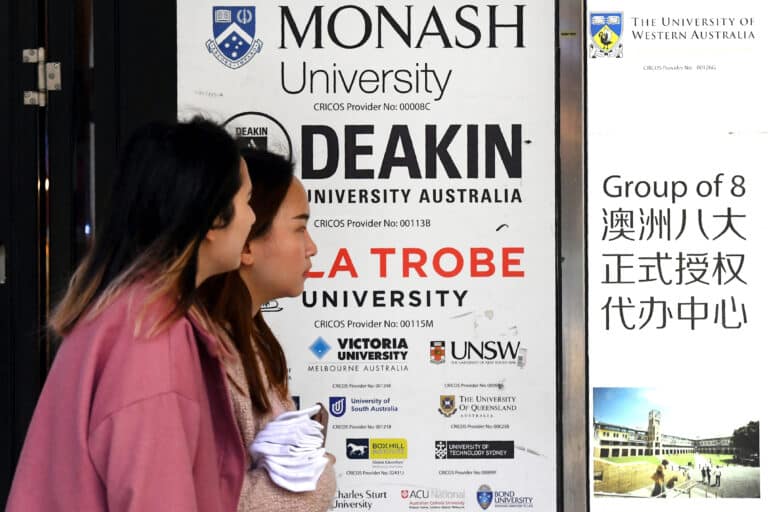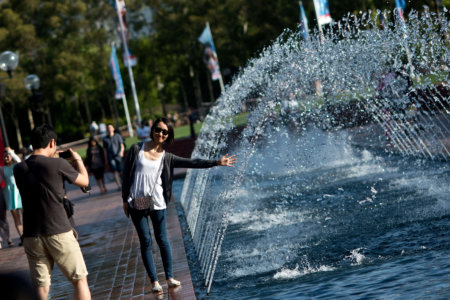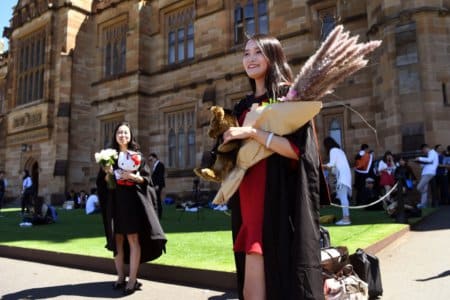
Australia is a favourite of many international students for good reasons. The country is home to a wide variety of universities and colleges with plenty of programmes and courses.
Pair that with how widely recognised they are, career opportunities, and that famous Australian lifestyle, it’s little wonder that studying in Australia is so popular.
You can find international students in every corner of Australia, spread throughout big cities like Melbourne, Sydney, and Brisbane, as well as in more regional areas, such as the capital Canberra.
Their presence is a key reason why the country is one of the most culturally diverse nations in the world.
As many as seven million people in Australia were born overseas — in 2021, they represented 27.6% of the population.
If you’re planning to study and live in Australia, it’s good to know about the latest updates in the Land Down Under.
The best Australian universities in 2024
Australia is home to some of the best universities, so you’ll definitely be spoiled for choice. Times Higher Education’s World University Rankings feature 37 top universities in Australia, all with world-class programmes and faculty.
According to the QS World University Rankings 2024, these are the top 10 universities in Australia:
- University of Melbourne
- University of New South Wales
- University of Sydney
- Australian National University
- Monash University
- University of Queensland
- University of Western Australia
- University of Adelaide
- University of Technology Sydney
- Macquarie University
If you’re looking for the best university from each state of Australia, check out our quick list:
- Sydney – University of Sydney
- Melbourne – University of Melbourne
- Brisbane – University of Queensland
- Canberra – Australian National University
- Perth – University of Western Australia
- Adelaide – University of Adelaide
- Tasmania – University of Tasmania

Great views make for great times outdoors in the city and in more rural areas. Source: AFP
What are the cheapest universities in Australia?
While the cost of studying in Australia depends on the programme you’re taking, there are a few affordable choices for students on a budget.
Here are our top three picks:
- University of Southern Queensland – Brisbane
A public university established in the year 1967, with over 110,000 alumni dispersed around 146 countries around the world. Tuition fees for international students start from 15,400 Australian dollars (US$10,170) a year. - Charles Stuart University – Bathurst
An Australian multi-campus public university located in New South Wales, Australian Capital Territory and Victoria. They pride themselves on being Australia’s #1 public university for graduate employment for seven years running. Fees for international students start at around A$23,600 (US$15,578) - University of the Sunshine Coast – Queensland
Another popular public university, and one of the youngest educational institutes in Australia. Founded in 1994, it proudly sits amongst the top 1000 universities in the world, and remains one of the most affordable ones. The tuition fees at USC for international students varies depending on the programme and start from A$25,480 (US$16,824) per year.
Seeking a master’s degree? Check out Torrens University’s fee schedule for international students — where we found several great options:
- Master of Business Administration at A$28,000 per year
- Master of Education (Inclusive Education) at A$25,200 per year
- Master of Economics of Sustainability at A$26,400 per year

Student Drew Pavlou posing for a photo on the campus of the University of Queensland in Brisbane. Source: AFP
Cost of living in Australia for international students
Is it expensive to live in Australia as an international student?
The estimated cost of living in Australia for international students is typically around A$20,000 Australian dollars per year. This is inclusive of accommodation, food and groceries, transportation, utilities and other miscellaneous things.
While the World Population Review ranks it as the seventh most expensive country to live in, that’s not a blanket truth for everyone across the country.
Your cost of living will depend on your state, city, and where you stay while studying in Australia.
The city and type of accommodation can play a big part in your budget as an international student – a shared dormitory or apartment would cost way less than a single apartment.
For example, in places like Sydney, you can expect to pay A$447 per week if you share a one-bedroom apartment 10 kilometres from the Central Business District.
International students looking for an affordable Australian city to stay in can consider going to Canberra, known as the least expensive city in the country.
Canberra is famously known for its vibrant atmosphere and busy nightlife, while home to top-ranked universities such as the University of Canberra and the Australian National University.

People take photos of the Sydney Harbour Bridge. Source: AFP
What you should know before studying in Australia
1. Stricter visa rules
Australia is set to implement stricter visa rules for international students and migrant workers over the next two years.
This decision was made as a response to a peak in migrant intake, largely driven by international students in 2022 to 2023.
The increase in numbers was initially aimed at addressing staffing shortages caused by stricter border control and regulations during the pandemic.
This in turn led to an exacerbated pressure on the rental market due to the influx of foreign workers and students.
“We do need to have our migration level brought to a sustainable level and we will be releasing the details of that this week,” said Prime Minister Anthony Albanese to reporters in Sydney.
“This is a response to the fact that the system is broken.”
A survey done for the Sydney Morning Herald said 62% of Australian voters said the country’s migration intake was too high.
Home Affairs Minister Clare O’Neil believes that by setting stricter rules and requirements for international students and migrant workers, migration numbers will return to normal.
Official data showed it was forecast to fall to about a quarter of a million in 2024-25 and 2025-26, similar to pre-COVID levels.
In addition, there would be more scrutiny for students who apply for a second visa to prolong their stay, whether for further study or work.
For special cases, a new specialist visa for highly skilled workers will be available to help businesses recruit top migrants amid tough competition, with only a one-week processing time.
2. Introduction to the subclass 500 student visa
This is the general student visa for international students in Australia.
It allows international students six years and older to remain in Australia for up to five years, for the purpose of full-time study at an educational institution.
International students will need to enrol in a programme of their choice and receive a confirmation of enrollment (CoE) first, before applying for a student visa.
Visa fees are from A$710 (US$469) unless you’re exempted.
As the Department of Home Affairs reviews visa applications on a case-by-case basis, it’s a good idea to check if you’ve provided all necessary supporting documents for your visa application.
Here are the basic conditions you need to take note of before studying in Australia:
- Prove that you have a welfare arrangement if you’re under 18 years old.
- Make sure to notify your university or training provider within seven (7) days of arriving in Australia.
- Be a good student – meet course requirements, remain enrolled and have good attendance.
- Inform your university or provider if you are ill or have any other chronic issues that may affect your attendance and performance.
- Pay attention to the limit on working hours, if you choose to take up part-time work while studying.
- Maintain good health insurance for your stay in Australia.

International students will be required to take an English proficiency test before they apply for a student visa. Source: AFP
3. Requirement for higher scores on English proficiency tests
Under the new visa policies, international students will be required to score higher ratings on their English proficiency tests if they intend on studying in Australia.
- Student visa: A score of 6.0 for IELTS (previously 5.5)
- Temporary Graduate visa: A score of 6.5 for IELTS (previously 6.0)
- For students in ELICOS (English Language Intensive Courses for Overseas Students): A score of 5.0 for IELTS (previously 4.5)
- Foundation or pathway programmes: No changes, IELTS score stands at 5.5
Australia currently accepts the following English language tests:
- IELTS (IELTS), including Single Subject Skills Retake (OSR)*
- PTE
- Cambridge English (CAE)
- OET (test developed for health professionals)
4. Increase in deposit requirements
To apply for a student visa, international students are required to submit evidence that they can afford to study and live in Australia.
This amount was previously A$21,041. It was changed in 2023 to A$24,505 (US$16,183), a 17% increase.
This increase was made to keep up with the current cost of living in Australia.
International students must be able to afford living in the country for their entire duration without solely relying on part-time work to stay afloat.
At the same time, they won’t be at risk of being exploited due to the urgent need for cheap employment.

International students usually work part-time serving cashiers, restaurants or coffee shops to earn extra money while studying. Source: AFP
4. Changes in working hours for international students
Previously in January 2022, the Australian government announced that foreigners studying in Australia would be allowed to work more than 20 hours a week.
This was to help international students with their cost of living while being away from home during the pandemic, while supplementing the shortage of workers as a result of border closures.
With the introduction of the new migration strategy, this change has now reverted.
On the positive side, this change will help students manage their time and priorities better.
Rita Kattady, an adviser at Western Success – a support programme for students – says that many students will benefit from the cap in hours.
“A majority of students will come to us during exam time, saying they’re struggling because they were picking up work hours,” she told The Guardian.
“While unrestricted hours gave them financial freedom, it’s also resulted in lots of stress.”
If you plan on working part-time while studying in Australia, there are some other things to note:
- You cannot work until you begin your programme at an Australian university
- You are allowed to work 48 hours per fortnight (every two weeks) during your course.
- During study breaks, international students are permitted to work unlimited hours.
- In the case where your programme includes work or training as part of the course, these hours won’t count towards the 48-hour restriction.
- For students pursuing a Master by Research or a PhD, there will be no limit implemented.

Australian Prime Minister Bob Hawke (L) and his wife Hazel Hawke (2ndL) welcome Britain’s Prince Charles, Prince of Wales and Diana, Princess of Wales, for a lunch given in their honour on November 7, 1985 in Canberra. Studying in Australia’s capital is said to be a more laidback and affordable option. Source: AFP
5. Temporary graduate visa changes (Subclass 485)
Among these decisive measures is the decision to cut the post-study work visa for international students by two years.
Undergraduates on selected programmes will only be able to stay and work in Australia for two years, and master’s students within certain disciplines will be allowed to stay for three.
So if you’re planning to stick around after graduation, take note!
The maximum age for this visa will also be lowered to 35.
For more insight on Australia’s plans for migrant workers, refer to the Migration Strategy document from the Australian Department of Home Affairs.










